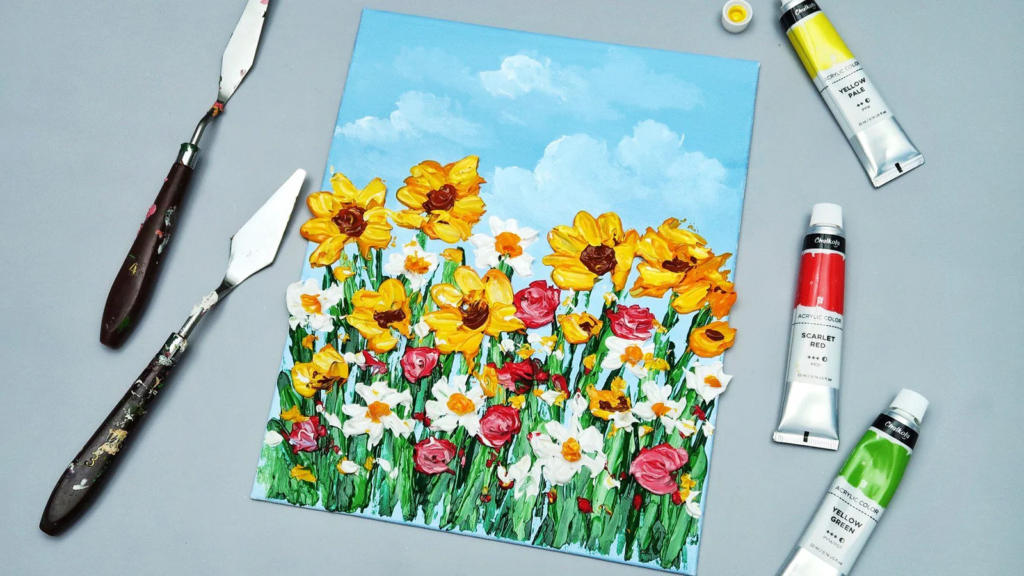Ever walked through a modern art gallery and been captivated by a painting? It might be a piece with the textured, buttery thickness of an oil painting, or a sleek, graphic design that looks like it was screen-printed. There’s a good chance that despite their vastly different appearances, they were both created with the same versatile medium: acrylic paint.
Acrylics are the chameleons of the paint world. They’re the favorite of everyone from famous contemporary artists like David Hockney and Mark Rothko to hobbyists and DIY enthusiasts. But what makes this 20th-century invention so incredibly popular and interesting? Let’s dive in.
The Magic Formula: What Is Acrylic Paint, Anyway?
At its core, acrylic paint is simple: pigment suspended in an acrylic polymer emulsion. Translation? Microscopic colored particles are floating in a water-based plastic solution.
This simple recipe is the source of its superpowers:
It dries quickly. Unlike oil paints that can stay wet for days, acrylics dry in minutes or hours. This allows artists to build layers rapidly and correct mistakes without a long wait.
It’s water-soluble. You can thin it, clean your brushes, and create watercolor-like effects using just water. No need for harsh solvents like turpentine.
It’s incredibly durable. Once dry, the acrylic polymer forms a flexible, waterproof plastic layer. It won’t yellow with age like oils can and is resistant to cracking.
Why Artists Are Obsessed: The Endless Possibilities
The real intrigue of acrylic paint lies in what you can do with it. Its adaptability is its greatest asset.
1. Master of Disguise: Mimicking Other Mediums
With a few techniques and additives, acrylics can impersonate their artistic cousins:
Like Watercolor: Add a lot of water, and you can create beautiful, transparent washes.
Like Oil: Use heavy body acrylics straight from the tube and add a gel retarder to slow the drying time. You can build up thick, impasto strokes that hold their shape perfectly.
Like Ink: Use fluid acrylics for precise line work, drip techniques (a la Jackson Pollock), or airbrushing.

2. The Additive Revolution
This is where the fun truly begins. You can mix acrylic paint with a huge range of mediums to completely alter its properties:
Gel Mediums: To add body and create texture.
Modeling Paste: To build up incredible, sculptural relief on the canvas.
Retarders: To slow drying time for more blending.
Glazing Liquids: To create thin, transparent, glossy layers of color.
Iridescent/Interference Mediums: To make your paints shimmer and change color depending on the viewing angle.
This ability to be customized makes acrylics less of a single paint and more of a creative toolkit in a tube.
Beyond the Canvas: The DIY and Craft Phenomenon
Acrylic paint isn’t confined to fine art. Its accessibility and durability have made it a star in the world of DIY. It’s the go-to for:
Home Décor: Upcycling furniture, painting flower pots, and creating custom wall art.
Fashion & Textiles: With the right medium, it can be used on fabric for custom t-shirts and tote bags.
Cosplay & Models: Its ability to adhere to various surfaces (plastic, foam, wood) and fine detail work makes it perfect for bringing creations to life.
The “Cons” (Or, Just Things to Know)
The very things that make acrylics great can also be their challenge. The fast drying time that helps with layering can be frustrating for artists who want to blend colors seamlessly on the canvas. The key is working in smaller sections or using retarders.
Also, because they darken slightly as they dry (and dry so quickly), color matching can be a tricky skill to master.
Getting Started: Your First Tube
Intrigued? Starting is easy and affordable.
Student Grade vs. Professional: Start with a student-grade set (like Liquitex Basics or Winsor & Newton Galeria). They are cheaper and perfect for learning. Professional grades (like Golden or Heavy Body Liquitex) have a higher pigment load for more vibrant colors.
Brushes: Get a few synthetic brushes in different shapes (round, flat, filbert). Acrylics can ruin natural hair brushes.
Surface: You can paint on almost anything, but primed canvas, canvas boards, or heavy-weight paper (like watercolor paper) are great starters.
Two Essential Extras: A jar of water for cleaning and a spray bottle to mist your palette to keep paints from drying out.
The Final Stroke
Acrylic paint is more than just a medium; it’s an invitation to experiment. It democratizes art-making, making it accessible, fast, and forgiving. It challenges the old rules and empowers artists to define their own process.
Whether you’re looking to create a masterpiece for a gallery wall, personalize a pair of sneakers, or simply unwind with a brush in your hand, acrylic paint is the versatile, powerful, and endlessly interesting partner you’ve been looking for. So grab a tube, get messy, and see where this shape-shifting powerhouse takes you.

